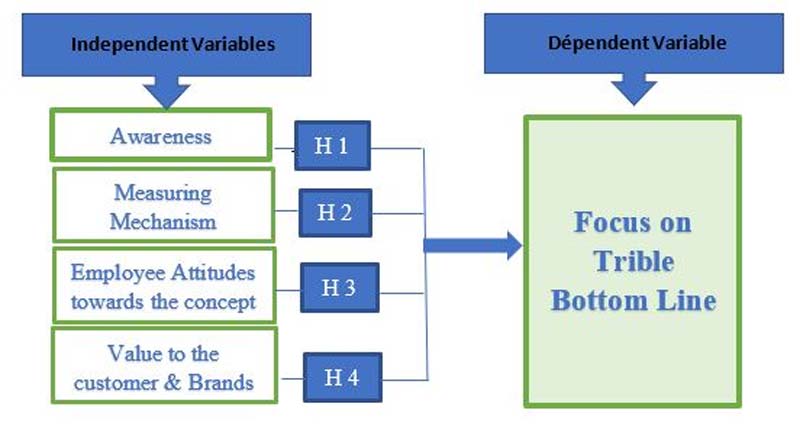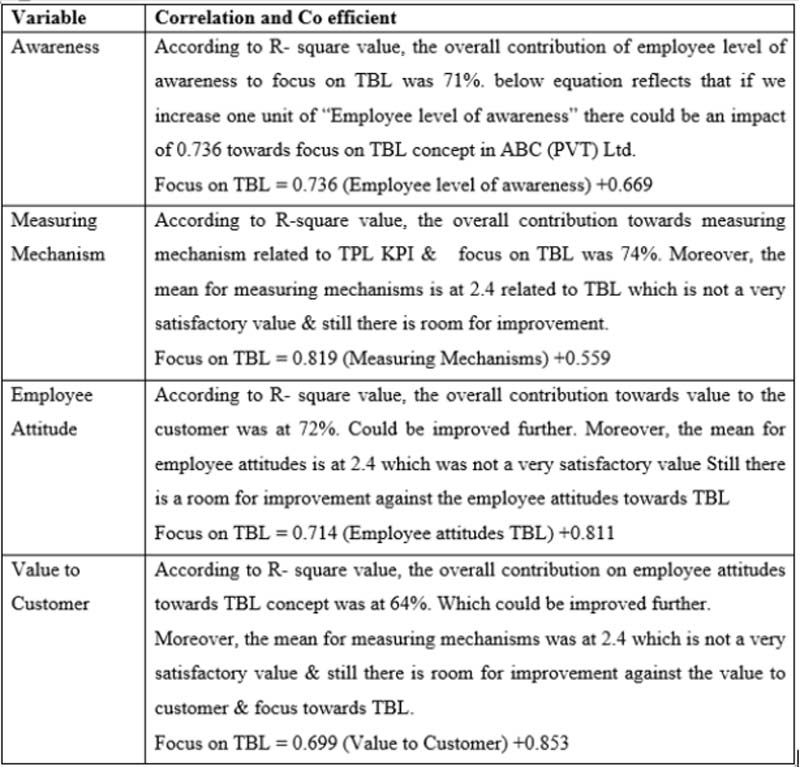Monday Dec 15, 2025
Monday Dec 15, 2025
Thursday, 5 October 2023 12:23 - - {{hitsCtrl.values.hits}}
By Chinthaka Perera, Deputy General Manager of Manufacturing Operations, BSC Eng, MBA.
 ABSTRACT
ABSTRACT
Over the past decades, many individual studies have taken place on sustainable performance. The recent introduction of the Triple Bottom Line (TBL) concept by John Elkington, has started to highlight how employee wellbeing is contributing towards an organization’s success. TBL the three-dimensional planet, profit, and people, and how these factors are interconnected with one another. This research study is focused on how this concept is practically used in the apparel industry. Moreover, the factors affecting the focus on the TBL concept are evaluated. The level of employee happiness has a positive relationship with the organization’s success. Further, supply chain partnership & their best practices impact the final product/service of the organization, hence a sustainable supply chain practice would be the key. The literature review emphasizes how selected key variables focus on TBL related to the Apparel Industry. It was observed that less or no empirical studies have been carried out regarding individual apparel-related organizations in Sri Lanka. Hence, a few international examples were considered in detail. Data collection was purely based on a questionnaire circulated among 65 individuals representing Executive & above-category employees in a leading garment manufacturing company. The objective of this research study is to identify the most significant factors that could affect the focus on the TBL concept related to the Apparel Industry. Based on research findings, recommendations and conclusions have been derived. Further empirical studies related to TBL could be carried out in the future considering more variables.
Keywords:
Sustainable performance, Triple Bottom Line, sustainable practices, Sustainable supply chain, Green Initiative
Introduction
The Apparel Industry & its related supply chain is becoming progressively worldwide, and this increasing level of outsourcing in developing countries, mainly in the South Asian region, was noted with an increasing demand for sustainability. In the Sri Lankan context as a key contributor to the Country’s GDP, the Apparel Industry needs to be investigated as to the Triple Bottom Line concept that could be practiced in the clothing sector. For this purpose, ABC (PVT) Ltd a key player in the clothing industry is selected. With the use of learnings from the TBL concept, business targets could be achieved at the minimum level balance among three variables; planet, people & profit. For this purpose, how individual companies are going to focus & what the variable factors that are going to get affected by the level of focus towards TBL, is investigated through this research study which was published on 18th June 2020

Figure i: Triple Bottom Line conceptual model
In the international context, “the clothing and textile business accounts for approximately $2 trillion in global revenue. Unfortunately, the industry’s liking for natural resource consumption, generation of greenhouse gases and pollution poses remarkable threats to environmental sustainability.” (Kim Y. Hiller Connell, 2017). As accountable practitioners, they are responsible for sustainable performance more than their economic objectives. In South Asian Regions commitment towards Ecological & Social factors is less than in the Western Region.
Significance of the study
It was noted that many individual studies had been conducted communicating sustainable practices, concentrating either on the monetary consequences or social consequences, disregarding the total consequence of the Triple Bottom-line approach. Sri Lanka is a developing country, and fewer empirical studies have been undertaken on the TBL concept related to the apparel Industry. It is visible that sustainable practices lead to sustainable performance even in developing economic conditions. The whole objective of this research study is to identify the most significant factors that could affect the focus on the TBL concept related to the apparel industry. On the other hand, this study will be beneficial to all manufacturers as well as to the supply chain members of the apparel industry. The research findings & supporting information will positively influence future decision-makers related to focusing on TBL in the apparel industry as a whole.
Research Objectives
1.Understanding how Apparel Industry employees are adhering to the TBL concept & its measuring mechanisms in a selected large apparel organization.
2.Identify the impact of employees’ attitudes towards the focus on the TBL concept among selected individuals in an identified large apparel organization.
3. Identify how the use of the TBL concept will add value to the end customer.
4.Identify the ways to improve focus on the TBL concept
Data collection was purely based on a questionnaire circulated among the selected sample size of 65 respondents, which is in accordance with Morgan’s calculation method. The selected sample represents the Executive & above-employee category. Moreover, qualitative data has also been extracted based on available literature & theories.
Methodologies
Conceptual Framework
The conceptual framework acts as an analytical tool that could be interpreted as a “map” of the research study. The design of the research included both quantitative parameters & qualitative data gathered from the questionnaire. In order to accomplish the main purpose of the study, the researcher selected four independent variables and developed the conceptual framework to carry out the research further. Similarly, a hypothesis has been developed and finalized in the operationalization table as well. For this study, the selected population is the executive & above-employees’ category and the stratified sampling method is used under probability sampling to choose respondents from each designation category. As a tool for data collection, questionnaires have been distributed among the selected sample, and finally, the gathered data has been analyzed using SPSS & Microsoft.
Conceptual Model

Figure ii; Conceptual Model
Hypothesis
H1a = There is a relationship between employee level of awareness about TBL concept & focus on TBL.
H1b = There is a relationship between TBL-related KPI measurements against the focus towards the TBL concept.
H1c= There is a relationship between employees’ attitudes toward TBL concepts and focus towards TBL concepts.
H1d= There is a relationship between value to the customer and focus towards the TBL concept.
Analysis
Hypothesis Analysis

Correlation and Coefficient Analysis

Conclusions and Recommendations
The outcome of the present research study revealed that there is a strong positive relationship between all the selected variables towards the focus on the TBL concept. At the same time, it was revealed that there is only limited / no research being carried out related to the use of the TBL concept related to the Apparel Industry.
It is understood that the company has undertaken quite a lot of green initiatives in the recent past. Unfortunately, the true inner meaning of such activities was not interconnected with TBL concept-related learnings.
Consequently, it is vital that individual organizations & their employees should identify the importance of sustainable performance. Moreover, this study will be advantageous to all manufacturers in the Apparel Industry. Research findings & support information will influence the future decision-making parameters related to focus on TBL.
With the use of the learning undertaken from this research study, the TBL concept is recommended to be adopted in achieving the business goals at least with a minimum level of balance between three variables; Planet, People & Profit. Accordingly, at present, the employee level of awareness towards the focus on the TBL concept is at 2.38 which is not a very satisfactory value and still, there is room for improvement. Hence employee level of awareness towards the TBL concept should be enhanced via formal training.
E.g.: Participation in forums, classroom learning awareness activities, online programs briefing towards all green initiatives undertaken by the company, competitions among employees on green concerns, awareness on greenhouse emissions, etc.
● Measuring mechanisms related to the mean value was at 2.4 related to TBL which is not very impressive, and still, there is room for improvement. Measuring mechanisms to be established among the departments by setting KPIs. Before setting the KPIs stakeholder consent should be obtained through brainstorming. KPI review should be conducted periodically with random audits on data collection methods.
● The mean value for employee attitudes was 2.4, which was not a very satisfactory value. A cultural shift towards a Triple Bottom Line Concept-related learning would be an added advantage in increasing the level of awareness and employee attitudes towards the TBL concept. Plus, senior management involvement towards TBL will automatically drive the employees toward a cultural shift.
● The mean value for value to the customer was 2.4, which is not very satisfactory. Still, there is room for improvement against the focus on TBL. Vendors such as GAP & Nike are willing to pay more for garments that are produced with Sustainable Initiatives. Through their respective Brand Positioning Strategies, sustainable value addition is to be promoted in a manner where the end user will benefit.
● Active engagement of sustainable officers of the company with other departmental individuals to make a cohesive effort to improve focus on TBL.
● Promote a suggestion culture with sustainable initiatives among the employees. For this purpose, team members also could be engaged.
Limitations of the study
The selected number of respondents may not represent the entire population as the sample size is limited to 65 respondents and therefore, it is not possible to make a solid decision. Also, the scholars’ personal biasness may distort the rationality of the information and its significance. However, this research study was carried out with an independent view, but the behavior of the selected respondents cannot be confirmed. However, it was assumed that the survey and the interview questions were answered truthfully, and respondents should have spent quality time answering questionnaires. Confidentiality of the provided information will be secured.
Future Research Suggestions for Practitioners
Moreover, it will reveal that there will be an inconsistency in the use of the term “sustainability”. The concept of the Triple Bottom Line means that the success of the business is no longer defined only in monetary terms, but also by the impact on the organization’s activities towards the society. In the recent past, a considerable amount of attention has been devoted to the “Triple-Bottom-Line in reporting”, as defined by Elkington (1997) as reporting which provides information about the economic, environmental, and social performance of the entity. For future researchers, this study would be expanded towards other labor-intensive large-scale industries in order to obtain more reliable research outcomes while focusing on qualitative parameters as well.
References
A, C., 2017. Crossman, A, 2017, ‘An Overview of Qualitative Research Methods’, ThoughtCo,. [Online]
Available at: https://www.thoughtco.com/qualitative-research-methods-3026555 [Accessed 20/07/2019 july 2019].
Ahlam, S. A., 2014. Sri Lanka can be a breakthrough nation in sustainability: Triple Bottom Line guru Daily FT e paper. [Online]
Available at: http://www.ft.lk/article/345896/Sri-Lanka-can-be-a-breakthrough-nation-in-sustainability--Triple-Bottom-Line-guru
[Accessed 20/07/2019 July 2019].
Anon., 2013. www.era-environmental.com. [Online]
Available at: https://www.era-environmental.com/blog/sustainability-management-triple-bottom-line
[Accessed 22/07/2019 July 2019].
Anon., n.d. s.l.: s.n.
Apparel Industry, S. L., 2019. 1-2. [Online]
Available at: https://en.wikipedia.org/wiki/Apparel_industry_of_Sri_Lanka
[Accessed 22/07/2019 July 2019].
Banning, G. a., September 22, 2011. Addressing Sustainable Apparel Design Challenges With Problem-Based Learning. [Online]
Available at: https://journals.sagepub.com/doi/abs/10.1177/0887302X11414874?journalCode=ctra
[Accessed 22/07/2019 July 2019].
Brundtland, G., 1987. Our common future: The world commission on environment and development.. England: Oxford.
CentalBank, 2014. Annual Report, s.l.: Central Bank.
Deniz Köksal 1, *. J. S. 1. M. M. 2. a. M. F. 1., 12 January 2017. Social Sustainable Supply Chain Management in the Textile and Apparel Industry—A Literature Revie. MDPI.
Depken, D. & Zeman, C., 2017. Small business challenges and the triple bottom line, TBL: Needs assessment in a Midwest State, U.S.A.. Science Direct, Volume 135, pp. 44-50.
Development, E. & Authority, 2016. Apparel & Textstyle Industry, s.l.: s.n.
Elkington, J., 1998. Cannibals with forks: 1he triple bottom line o/21" century business. , s.l.: New Society Publishers..
Francis , . .. U. & Fidelis, O. . A., 2016. TRIPLE BOTTOM LINE REPORTING PRACTICES AND CORPORATE RELATIONSHIP WITH HOST COMMUNITIES IN NIGERIA, s.l.: s.n.
Goel, P., 2010. Triple bottom line reporting: An analytical approach for corporate sustainability. Journal of Finance, Accounting, and Management, Volume 1(1), pp. 27-42.
GRI, 2008. Global Reporting Initiative. [Online]
Available at: www.globalreporting.org
[Accessed 30 August 2019].
Guide, S. L. C. C., 10/10/2018. Export.Govn. [Online]
Available at: https://www.export.gov/article?id=Sri-Lanka-Textiles
[Accessed 16/07/2019 July 2019].
Hart, L. S. & Mark , B. M., 2003. Creating sustainable value. Academy of Management Executive, Volume 17, p. 2.
Islamia, J. M., September 2016. Research Design. [Online]
Available at: https://www.researchgate.net/publication/308915548
[Accessed 04//02/2020 February 2020].
Kim Y. Hiller Connell, J. M. K., 2017. Introduction to special issue on sustainability and the triple bottom line within the global clothing and textiles industry. Department of Apparel, Textiles and Interior Design, College of Human Ecology, Kansas State University, 219 Justin Hall, Manhattan, KS 66506, USA..
Landroguez, S. M., Castro, B. C. & Cepeda , C. G., 2013. Developing an integrated vison of customer value.. Journal of Services Marketing, Volume vol. 27, p. 234 – 244..
Molar, P. R. M. &. E., 2003. Sustainability-focused Organizational Learning:. Journal of Environmental & Planning Management, 46(2), p. 3.
Molnar, E. & Mulvihill, P. R., 03 Aug 2010. Sustainability-focused Organizational Learning: Recent Experiences and New Challenges, s.l.: s.n.
Mustamil, M. N. & Abdul Wahid, . K. N., April 2017. Ways to maximize the triple bottom line of the telecommunication industry in Malaysia. Journal of Organization Change Mangement, Volume 30, pp. 263-280..
N, G. N., 2003. Understanding Reliability and Validity in Qualitative Research,. The Qualitative Report 8(4), pp. pp-597.
Polit, H. &., 1999. Population. Nursing research: principles and methods. Phildelphia: JB Lippincott Company., Issue 1999, p. P 37.
S. Sapukotanage, B. W. S. Y., 2018. Outcomes of Sustainable Practices: A Triple Bottom Line Approach to Evaluating Sustainable Performance of Manufacturing Firms in a. International Business Research, 11(doi:10.5539/ibr.v11n12p89 ), p. 3.
Samuel, A., 6 August 2018 . Daily Mirror. [Online]
Available at: http://www.dailymirror.lk/article/Social-awareness-of-the-corporate-sector-153624.html
[Accessed 22/07/2019 july 2019].
Savenye, R., 2004. 55 Data Collection and Analysis. 55 Data Collection and Analysis, p. 22.
www.emerald.com/insight/content/doi/